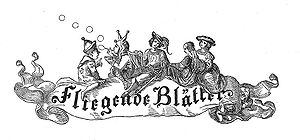Braun & Schneider publishing house
The Braun & Schneider publishing house is a publishing house founded in 1843 by Kaspar Braun and Friedrich Schneider .
The publisher was preceded by Caspar Braun & v. Dessauer, Institute for Wood Cutting Art (also Xylographische Anstalt , XA ), which was founded by Kaspar Braun in 1838 with Georg von Dessauer as a partner in Munich. Kaspar Braun thus took up the technique of wood engraving , which was further developed by Thomas Bewick towards the end of the 18th century , which in the 19th century developed into the leading reproduction technique for illustrations. The publishing house, which was newly founded after Friedrich Schneider left the company, initially printed images of saints, Christian Catholic picture sheets and booklets such as the "Stations of the Cross".
In 1844 the publishing house expanded its program to include a satirical newspaper, the Fliegende Blätter , the success of which was the reason to publish the Munich Bilderbogen from 1848 onwards . The fact that Kaspar Braun employed students from the art academy for his illustrations, for whom he drew a lower and, above all, one-off fee, contributed to the success of the publishing house. One of the art students who were employed in this way was Wilhelm Busch . In the following years, Kaspar Braun increasingly relied on well-known figures such as Moritz von Schwind , Franz Graf von Pocci , Carl Spitzweg and Ludwig Bechstein .
The publisher was also style-defining. Between 1854 and 1857 the friends Adolf Kussmaul and Ludwig Eichrodt published a number of comically exaggerated poems, which came out under the title Auserlesene Gedichte by Weiland Gottlieb Biedermaier . In the Fliegende Blätter, among other things, Busch's picture stories Die kleine Honigdiebe and The small painter with the large portfolio as well as in 1865 Der Virtuos , which is considered one of the most revolutionary and ingenious picture stories of Wilhelm Busch, appeared. The purchase of the image rights to Max and Moritz , which Kaspar Braun acquired in February 1865, also proved to be a stroke of luck in publishing . The first edition of 4,000 copies sold only hesitantly, but in the medium and long term it turned out to be the publisher's greatest sales success. On the occasion of his 70th birthday in 1902, the publisher therefore sent Wilhelm Busch a gift of 20,000 Reichsmarks (approx. EUR 200,000), which Wilhelm Busch donated to two hospitals in Hanover.
The abbreviation XA ( Xylographische Anstalt ) can also be found on prints after the publishing house was founded in 1843.
literature
- Joseph Kraus: Wilhelm Busch. Rowohlt, Reinbek 1970, 17th edition 2007, ISBN 978-3-499-50163-0 , p. 77.
- Gudrun Schury: I wish I were an Eskimo. The life of Wilhelm Busch. Biography . Aufbau-Verlag, Berlin 2007, ISBN 978-3-351-02653-0 , p. 156.
Single receipts
- ↑ Schury, p. 77.
- ↑ Kraus, p. 156.
- ↑ Moritz Barach: Please be nice - singa lass'n !. Poems in the Salzburg dialect . Heinrich Dieter, Salzburg 1878 (lettering on the brochure: XA v. Braun u. Schneider ).
Web links
- The Braun & Schneider publishing house. Regensburg University Library , accessed on January 26, 2018 .

